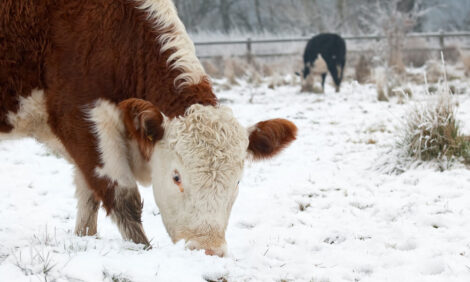



Meat Producers Need Big Grain to Improve Margins
US - The pounds of meat produced in the United States will drop in 2013 for the second time in five years. That includes beef, pork, chicken and turkey, according to a report given to Congress, writes Duane Dailey, Senior Writer at University of Missouri.Livestock farmers struggle to fill growing world meat demand, not because of low prices but because of high costs, Scott Brown, University of Missouri economist, reported to House and Senate agriculture committees.
The annual MU economic baseline projects production and prices for the coming decade.
"When we look at 2013, the big issue for livestock and dairy farmers is feed costs. If we get a decent crop in the bin this fall, 2013 and beyond looks much better," Dr Brown said.
Crops have produced below-trend-line yields for three years, with 2012 bringing lowest yields.
"Having the worst drought in decades mattered a lot," Dr Brown said. "Many livestock farmers remain in business, hoping feed costs subside, bringing a better financial situation."
Size of US beef herds dropped in the face of less forage and feed. On the hog side, sow inventory remained stable despite sharp increases in feed costs.
Weather remains a big unknown in price projections. For their analysis, MU economists assume normal weather ahead.
"Producers see record livestock prices, but no record profits," Dr Brown said. "Market signals encourage increasing cow herds. Even with good beef prices available, it takes time to rebuild cow herds.
"For cow-calf producers, it is more than feed costs when forage was not available in drought-stricken areas." Producers remain concerned about available pasture.
For years, beef dominated the meat industry in terms of production, Brown said. As recently as 1995, beef was tops. However, by the fourth quarter of 2013, pork production may eclipse beef for the first time since 1962.
More than costs are in play in the baseline. The general economy remains a big unknown in the projections.
"The US needs economic growth to sustain record prices," Dr Brown said. "Meat prices have stayed strong in the worst economic downturn in decades."
If anything causes job growth to slow or if the economy heads into recession, those meat prices can't be sustained.
Dr Brown doesn't expect inflationary food prices. "Beef prices were up 49 per cent in 2012, compared to 2000-2006," Dr Brown said. "The challenge will be to maintain prices."
US consumers have changed eating habits, reducing meat consumption by 20 pounds per person. Mainly, that drop comes from lower availability. If feed prices decline, meat supplies should grow.
At the same time, growing international demand takes more meat, particularly high-quality beef, out of this country. That export demand, especially from the Asia/Pacific region, grows with rising middle-class earnings.
"Economies of those developing countries show real growth of 6 to 7 per cent per year. That helps our meat sales."
Increasingly, US dairy products compete in the world market, Dr Brown said. Now, the US exports half of its nonfat dry milk. "Dairy farmers are garnering a larger share of the international trade."
As domestic fluid milk consumption declines, that export trade becomes essential.
Dairy producers faced high feed costs in times of low and volatile milk prices. While milk prices recovered in late 2012, farm receipts remained below cost of production for many producers.
"Like livestock producers, dairy producers need a larger projected crop in 2013 to lower future feed costs and improve net returns."
In 2012, feed costs approached $64 billion, more than double 2006.
The livestock and dairy projections are included in a 50-page briefing book, US Baseline Briefing Book: Projections for Agricultural and Biofuel Markets. It was prepared by the MU Agricultural Markets and Policy team (amap.missouri.edu). The book can be seen at the MU Food and Agricultural Policy Research Institute website at www.fapri.missouri.edu.
The economic units are in the MU College of Agriculture, Food and Natural Resources.



